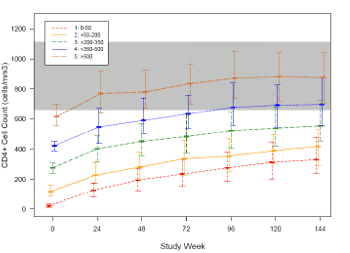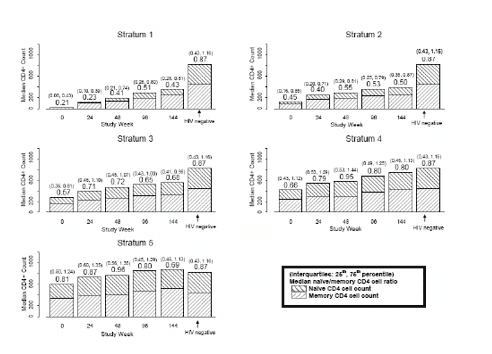 |
 |
 |
| |
Baseline CD4 Cell Count and Immune Reconstitution During Combination Antiretroviral Therapy in ACTG 384
|
| |
| |
Reported by Jules Levin
4th IAS Conference, July 2007, Sydney, Australia
Richard Pollard
Univ. of California-Davis Medical Center
Gregory Robbins1, John Spritzler2, Ellen Cha2n, David Asmuth3, Rajesh Gandhi1, Benigno Rodriguez4, Gail Skowro5n, Paul Skolnik6, Robert Shafer7, Richard Pollard, and the ACTG 384 Team.
1Massachusetts General Hosp., Harvard Medical School; 2Harvard School of Public Health; 3Univ. of California-Davis Medical Center; 4Case Western Reserve Univ. School of Medicine; 5Roger Williams Medical Center; 6Boston Univ. School of Medicine; 7Stanford Univ. Medical Center
"....The authors concluded that subjects who started with CD4 cell counts >350 cells/mm3 were more likely to reach the "normal" range for total CD4 and other immune cell subsets, and that these data suggest earlier initiation of ART.... These data support consideration of earlier initiation of ART (>350 CD4 cells/mm3) to allow restoration of normal T-cell populations." Median naive CD4, memory CD4, naive"memory CD4 cell ratio, and CD4:CD8 cell ratios all increased more over the 144 weeks of HAART in patients starting therapy with higher baseline CD4 counts.
At the end of this report are links to NATAP reports from IAS on the negative outcomes reported for patients associated with low CD4 counts, all the authors of these studies suggest starting HAART earlier, when CD4 counts are above 350. Some studies find benefits for patients with CD4 greater than 500 compared to patients with 350-499 suggesting benefits to starting HAARt when CD4 counts are >500. So, we have come full circle. In the early days of HAART 10 years ago it was suggested that HAART should be started in patients when CD4 counts were high but this was nixed due to fears of side effects, non-adherence, concerns about body composition changes, impact of quality of life, and drug resistance fears. But now therapies are easier to take and more convenient, have less side effects, and the chances of developing body changes particularly lipoatrophy (fat loss) are reported in studies to be relatively low. Perhaps it is time for Guidelines Committees to re-address when to begin HAART.
Several studies have shown that patients who start ART with lower baseline CD4 cell counts tend not to catch up to those who start with higher counts (Garcia 2004, Moore 2005, Moore 2007). Starting ART before CD4 counts fall below 200 has been shown to have a survival benefit (Egger 2002, Palella 2003), however there is no clear benefit from using higher CD4 thresholds for initiating ART.
Dr. Richard Pollard presented the findings of a secondary analysis of ACTG 384. 621 out of the ACTG 384 study cohort (n=980) had comprehensive assessments of immune cell subsets (total CD4, niave CD4, memory CD4, activated CD4, CD8, activated CD8, NK and B cells). Baseline CD4 strata (1 to 5) were defined as <50, 51-<200, 200-<350, 350-<500 and >500 cells at baseline.
Total CD4 cell counts for subjects in the lower CD4 strata failed to catch up to those starting with higher CD4 cell counts, and there appeared to be some slowing in CD4 increase by year 3 in the highest stratum, you can see in graph immediately below). Comparing change in CD4 from baseline, there were no difference by strata after week 24 (similar delta CD4 cell count). There was also no difference in delta CD4 cell count by ART regimen (as previously reported by the 384 team); patients in lowest CD4 stratum, <50 CD4s at baseline had a median CD4 count of 21, delta CD4 increase by week 144 was 302 cells (total Increase) to 333 cells. Patients who started study 384 (by the way I was the community rep on this study when it started in the ACTG I think about 7 years ago) in the highest CD4 stratum >500 CD4s had a baseline median CD4 count of 616, and their delta CD4 increase by week 144 was similar to the lowest straum and to the other stratums, 269 CD4 increase, and their median CD4 count after 144 weeks was 882. So, the point is that although the increase in absolute CD4 counts was similar for all patients in this study the highest level that could be reached is limited in patients who start therapy at a low CD4 count. This limits the level of immune reconstitution they can achieve. And we see in the latest studies coming out of IAS and in other recent conferences and journal publications that non-AIDS events such as heart disease, liver disease, and cancers appear to be associated with the CD4 count. This is leading to much discussion that perhaps HAART should be started earlier than current guidelines recommend.

Figure - Median (1st, 3rd interquartiles) CD4 cell counts by baseline CD4 strata (<50, 51-<200, 200-<350, 350-<500 and >500 cells/mm3). Shaded area represents HIV-negative controls.
Although total CD4 cell increases were similar there were notable difference in immune cell subsets. Comparing CD4 naive:memory cell ratios, subjects starting in the lowest CD4 strata (<50) had a median CD4 naive:memory cell ratio of 0.21 and after 3 years of ART this failed to reach even the pretreatment ratios for the other strata.

Figure: Median CD4 naive:memory cell ratios by Strata and study week (ratio for HIV-negative patients is shown on right =0.81.
The authors concluded that subjects who started with CD4 cell counts >350 cells/mm3 were more likely to reach the "normal" range for total CD4 and other immune cell subsets, and that these data suggest earlier initiation of ART.
ABSTRACT
Objectives: To determine if reconstitution of T-cell subsets is affected by baseline CD4 cell counts.
Methods: Using data from 978 subjects (621 w/advanced flow cytometry) on ACTG 384, a randomized trial of initial ART strategies, we compared CD4, CD4 naive, CD4 memory, CD8 cells during the 144 weeks of ART among subjects in different baseline CD4 cell count strata (≦50, 51-200, 201-350, 351-500, and >500 cells/mm3; results presented in this order).
Results: Absolute CD4 cell counts in the lower strata failed to reach those in the higher strata, although delta CD4 cell counts were similar for all strata throughout 144 weeks. Baseline CD4 naive:memory cell ratios (medians 0.21, 0.45, 0.57, 0.66, 0.81) were lower in the lower strata; similarly at week 144 (medians 0.43, 0.50, 0.68, 0.80, 0.69) and weeks 48 and 96 (p<0.01 at all time-points, trend test). T-cell subsets in subjects with baseline CD4 counts >350 cells/mm3 approached or were within the normal range for absolute CD4 cell, CD4 naive cell, CD4 memory cell counts, and CD4 naive:memory cell ratios. In contrast, subjects who began ART with ≦350 CD4 cells/mm3 generally failed to regain normal values. Median CD4:CD8 cell ratios at baseline (0.05, 0.18, 0.34, 0.49, 0.64) were lower than HIV negative controls (2.02, ACTG A5113), and remained low at week 144, especially in subjects with baseline CD4 cell counts ≦350/mm3 (0.40, 0.51, 0.69, 0.91, 1.19).
Conclusions: T-cell deficits were most notable for subjects in the lowest CD4 cell stratum, whose median CD4 naive:memory cell ratio after nearly 3 years remained below the baseline values of other strata. Median CD4:CD8 ratios for all strata appeared to be lower than HIV-negative controls, especially those in the lower strata. These data support consideration of earlier initiation of ART (>350 CD4 cells/mm3) to allow restoration of normal T-cell populations.
From Poster
AUTHOR CONCLUSIONS
1. CD4 cell count increases (delta CD4) from baseline were similar across strata, after week 24.
2. Since delta CD4 was similar across strata and study regimens, it may be possible to compare patients' CD4 responses to the 384 cohort.
3. There was a suggestion of a CD4 cell plateau among those starting with
a CD4 cell count >500 (stratum 5).
4. Similar to prior reports, subjects who started ART with lower CD4 cell counts did not catch up to those who started with higher CD4 cell counts, even after 144 weeks of ART.
5. T-cell ratios (naive/memory CD4 and CD4/CD8) were markedly altered in the lower strata and failed to normalize despite 144 weeks or ART.
6. Subjects who started ART with CD4 cell counts >350 achieved reconstitution of T-cell subsets to levels similar to that of HIV-negative controls (ACTG 5113).
7. These data support consideration of initiating ART at CD4 cell counts >350 to allow for reconstitution of normal T-cell populations
BACKGROUND
Earlier reports have described differences in CD4 cell count increases after initiating ART based on baseline CD4 cell count (Landay, CID 2007; Moore, CID 2007; Goicoechea, JID 2006; Garcia, JAIDS 2004; Egger, Lancet 2002). We
sought to expand on these observations by describing changes in T-cell subsets based on baseline (pretreatment) CD4 cell count.
Prior 384 immunology results:
ACTG 384 was a large international trial (US and Italy) that compared different ART treatment strategies in treatment-naive subjects. We previously reported, CD4 cell count increase among ACTG 384 subjects was not affected by initial
treatment assignment [Gandhi, JAIDS 2007]. Similar to other analyses, younger
age, female gender, higher baseline naive:memory CD4 cell ratio, higher baseline plasma HIV RNA, and virologic suppression after starting ART were associated with greater increases. A subset of subjects had <100 CD4 cell/mm3 increase despite long-term virologic suppression, and this immune deficit correlated with persistent T-cell activation. We now report on differences in immune cell counts according to baseline CD4 cell count stratum and compare these values to healthy HIV-negative subjects
METHODS
Study definitions:
Baseline CD4 cell count strata 1-5 were defined as ≦50, 51-200, 201-350, 351- 500, and >500 cells/mm3, respectively. Time to virologic suppression was the time to first VL <50 copies/mL, as determined by study week. Age was dichotomized as ≦ or >40 years. Immunologic success was defined as ≥100 CD4 cell count increase from baseline.
Three-color flow cytometry was performed using fresh cells according to the ACTG advanced flow protocol. The immune subsets were defined using the following markers: naive CD4 cells defined by CD4(+), CD45RA(+) and CD62L(+); memory CD4 cells defined by CD4(+), CD45RO(+) and CD45RA(-);
B-cells defined by CD3(-) and CD19(+); activated CD4 and CD8 cells defined by
either CD4(+) or CD8(+), plus CD38(+) and HLA-DR(+); and natural killer (NK)
cells defined by CD3(-), CD56(+) and/or CD16(+).
Normal ranges for T-cell populations were calculated using data from ACTG
A5113, which studied 48 healthy HIV-negative subjects, half 18 to 30 and half ≥45 years old[36]. The lowest of the first quartiles and highest of the third quartiles for the two age groups were used for comparison, and these appear as shaded bands on figures.
Statistical methods:
Analyses were based on all available data, regardless of whether subjects were virally suppressed. The nominal level of statistical significance used for these exploratory analyses was 0.05. Tests were two-sided, and not adjusted for multiple testing. Median, first and third quartiles are indicated as "median (Q1,
Q3)". Continuous outcomes were compared among baseline strata with a Jonckheere-Terpstra (JT) trend test, or between 2 groups with a Wilcoxon Rank Sum test.
Categorical outcomes were compared with a Cochran-Armitage trend test or
Fisher's exact test. Baseline stratum was based on the mean of the pre-entry and
entry CD4 cell counts except when testing the association between baseline
stratum and change in CD4 count from baseline, in which case the baseline
stratum was based on the pre-entry CD4 cell count only, and the entry CD4 cell
count was used to calculate the change from baseline.
|
| |
|
 |
 |
|
|